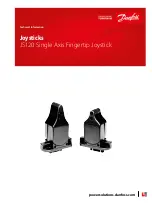
Chapter 7 Earthing and Shielding
GFK-2958E
RSTi-EP User Manual
329
7.1.1
Shielded Cables Increase Interference Resistance
The sources of interference voltages can rarely be eliminated and even then not always completely.
Thus, it is necessary to take measures to combat their effect. In general, the more effectively
interference voltages can be kept away from circuit elements or can be discharged, the less
electrical circuits are affected. This can be accomplished in a variety of ways with varying levels of
effectiveness. A very effective measure, in particular for safeguarding against inductive effects, that
is, ensuring
electromagnetic compatibility
(EMC), is the shielding of electrically functional components
to earth potential. In doing so, for instance, components are installed in metallic, earthed housings
and the connecting lines are equipped with shielding.
In general, it can be said that interference from cables can be combated by routing cables as far
away as possible from each other, keeping the common return as short as possible and using
twisted-pair wire. Far better protection, however, is provided by completely shielding of all cables.
This is the most effective measure that can be taken against the coupling of interference signals.
The best type of shielding consists of a braided mesh sleeve that uses individual wires made of non-
magnetic materials (copper, aluminium). The braided mesh should be sufficiently large and also be as
thick as possible. For cables that are equipped with foil shields, it is necessary to be aware of the low
mechanical strength and the low current-carrying capacity of the shielding.
7.1.2
Proper Use of Shielded Cables
The shielding of cables will only result in the desired effect if this is implemented properly. Incorrect
earthing or the use of improper components that perform their task inadequately reduces or even
totally eliminates the effect. Placing the shielding at any spot on the earth potential will not suffice, as
this earth connection may have no effect on high frequencies. In addition, ground loops must also be
taken into consideration. Furthermore, the shielding should be earthed over a large surface area.
Beyond that, the quality of the shield conductor and earthing accessories is also important.
In practice, the shield is still often twisted and connected to a terminal point. There is very high
attenuation (voltage drop) on these connections, especially for high-frequency interference.
Therefore, this type of shielding should not be used, even for short cable lengths. The shielding of the
cable is practically negated and can, at best, be helpful for lowfrequency interference. We
recommend that there is a large amount of surface contact with the braided shield of the cable.
There are generally four distinct types of coupling:
•
Galvanic coupling
•
Capacitive coupling
•
Inductive coupling
•
Radiation coupling
These types of interference usually occur mixed together, but they can be categorised as follows:
•
Electromagnetic fields
•
Ripple voltage (50 Hz)
•
Lightning
•
Interference pulses (current, voltage)
•
Transient surge voltages
•
Radio interference
•
ESD (electrostatic discharge)
•
Burst
•
Mains feedback
Summary of Contents for GFK-2958E
Page 1: ...RSTi EP User Manual GFK 2958E November 2017 ...
Page 23: ...Chapter 1 Introduction GFK 2958E RSTi EP User Manual 19 Notes ...
Page 56: ...Chapter 3 Configuration GFK 2958E RSTi EP User Manual 52 Notes ...
Page 183: ...Chapter 5 Detailed Descriptions of I O Modules GFK 2958E RSTi EP User Manual 179 EP 5111 ...
Page 184: ...Chapter 5 Detailed Descriptions of I O Modules GFK 2958E RSTi EP User Manual 180 EP 5111 ...
Page 316: ...Chapter 5 Detailed Descriptions of I O Modules GFK 2958E RSTi EP User Manual 312 Notes ...
Page 330: ...Chapter 6 Installation GFK 2958E RSTi EP User Manual 326 Notes ...
Page 344: ...Chapter 7 Earthing and Shielding GFK 2958E RSTi EP User Manual 340 ...
Page 345: ...Chapter 7 Earthing and Shielding GFK 2958E RSTi EP User Manual 341 Notes ...
Page 385: ...Chapter 8 Web Server GFK 2958E RSTi EP User Manual 381 Notes ...
Page 401: ...Chapter 11 Disassembly and Disposal GFK 2958E RSTi EP User Manual 397 Notes ...
Page 413: ...Chapter 12 LED Indicators and Troubleshooting GFK 2958E RSTi EP User Manual 409 Notes ...
Page 416: ...Chapter 14Accessories and Replacement Parts GFK 2958E RSTi EP User Manual 412 Notes ...
















































